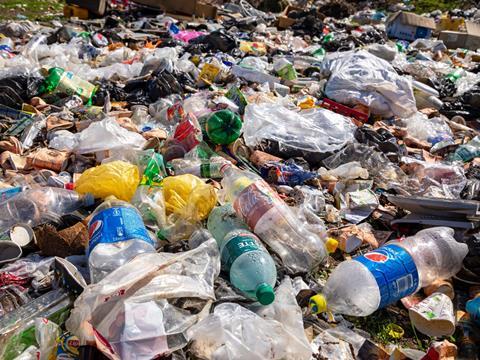
In November, a committee convened by the United Nations in Nairobi (INC-3) will discuss an international and legally binding treaty that it hopes will bring an end to plastic pollution. Riley McCormack, president and CEO of Digimarc, gives his views on some of the key factors the participants should bear in mind.
Humanity faces an existential crisis. If we don’t reduce our current rate of carbon emissions, we will cease to have an inhabitable planet, and thus cease to exist.
The severity of this outcome (human extinction) should be driving us to implement impactful solutions regardless of cost and effort. Instead, any solution that comes with either cost or effort brings excuses, and those excuses lead to inertia – despite time being something we don’t have.
But what if there were a technology capable of meaningfully reducing carbon emissions that works (has been thoroughly tested), can be adopted with relatively low effort (is in the initial stages of large-scale adoption), does not require government subsidy (in fact comes at a negative cost), and also addresses the issue of plastic pollution (by increasing both the quality and quantity of plastic recyclate)? What would be our excuse then?
This infographic from the Ellen MacArthur Foundation is so powerful because it clearly conveys the impact that higher quality plastics recycling would have on reducing carbon emissions, as well as the fact that – unlike similarly transformative carbon reduction technologies such as wind or solar power generation – it won’t require governments to subsidize adoption because it comes at a negative cost.
Key to achieving higher quality plastics recycling is improving upon current plastic sortation technology, because current sortation technology not only fails to detect entire classes of should-be recyclate, but it is also limited in its ability to provide a precise sort of the material it does detect. The consequence of these two limitations is a greater-than-necessary use of virgin plastic, and thus greater-than-necessary carbon emissions.
The reason why failing to detect entire classes of plastics leads to an increase in virgin plastic use is obvious – such plastic goes to incineration or landfill. The reason imprecise sortation increases virgin plastic use is two-fold: it leads to a limited variety of available recyclate types, and it degrades bale purity, which leads to lower recyclate quality, which in turn reduces applicability and usability.
Fortunately, the next-generation sortation technology needed to perform higher quality plastics recycling is ready: it has been thoroughly tested by industry stakeholders and in fact, initial scaled adoption is happening.
It is called digital marking and involves the addition to packaging of easy-to-detect machine-readable codes that link to an extensible database of relevant packaging attributes. Digital marking drives circularity by enabling more items to be detected and then allowing these items to be sorted using deterministic criteria of the recycler’s choosing, increasing the types of available recyclate as well as improving the purity of each bale.
But beyond just immediately improving the quantity and quality of available recyclate, digital marking also generates a massively valuable by-product: never-before-seen data about the plastics waste stream itself.
Data is essential to solve problems as large and complex as plastic pollution because data not only helps solve known problems efficiently, but it also allows the discovery of solutions to problems not even known to exist. Already the industry has envisioned multiple ways to mine this data (such as more efficient, effective, and fair Extended Producer Responsibility schemes; more sustainable packaging design; and reduced packaging volume via the discovery of actual shelf-life requirements).
Moreover, the history of data analytics suggests we haven’t even scratched the surface in terms of the methods and amount of ultimate value that will be created once we simply begin the long-overdue journey of analyzing this data, something digital marking of packaging finally enables.
The European Commission (EC) has witnessed firsthand the power of digital watermarking – a specific type of digital marking – via the Holy Grail initiatives. As a result, they included language requiring digital marking of packaging in their proposal for a revised Packaging and Packaging Waste Regulation. The EC understands the value digital marking will bring to improving existing sortation today, as well as the value its incredible by-product – data – will bring tomorrow.
The industry stakeholders who are now beginning a scaled rollout of digital watermarking also understand this technology’s multi-faceted benefits, and we applaud them– as well as the European Commission – for not just their vision, but more importantly, for their action. When the only thing that stands between a problem and a solution is overcoming inertia, leadership is defined by those who do, not those who see.
The world now turns its eyes to Nairobi, where the third session of an UN-convened Intergovernmental Negotiating Committee (INC-3) will discuss the Zero Draft of an international and legally-binding treaty to “end plastic pollution” with a “comprehensive approach that addresses the full lifecycle of plastic.”
We urge the INC-3 negotiators to seize this historic opportunity and adopt language requiring digital marking of plastic packaging in the treaty. Doing so will not only provide the means to achieve numerous objectives already outlined in Zero Draft, but it will also extend the impact of the EC’s action – and thus the benefits of digital marking – beyond just Europe. This is a global problem –the solution must be global, too.
It is unprecedented that such a powerful, proven, and economically viable solution to a literally existential crisis is available. And we’re not just running out of time to require global adoption – we’re running out of excuses.
If you liked this article, you might also enjoy:
The L’Oréal approach to packaging sustainability
What steps is Apple taking to make its packaging more sustainable?
How did Brazil achieve its 100% aluminium can recycling rate – and can it be replicated in the EU?
Experts have their say on the EU’s Packaging and Packaging Waste Directive revisions
















No comments yet